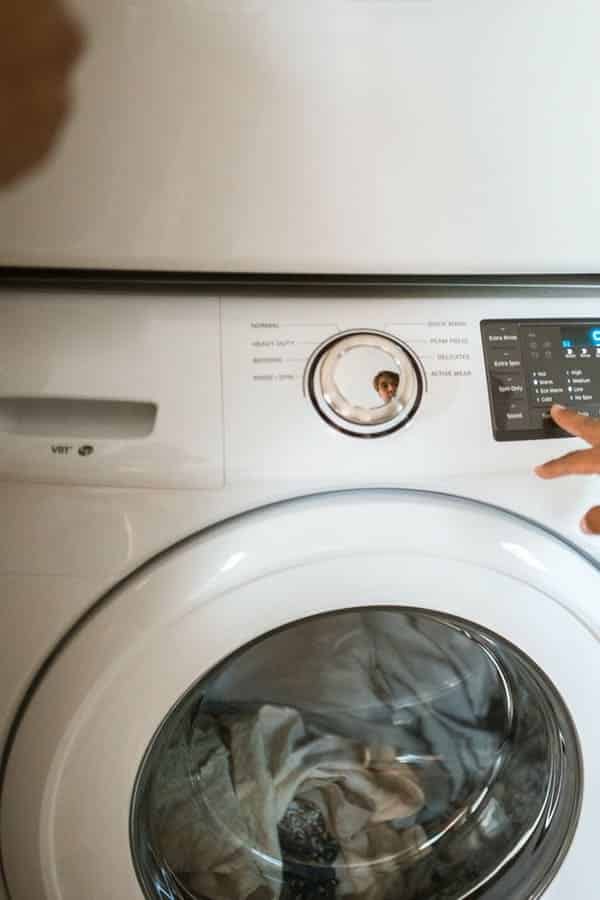Have you noticed dark stains on clothing after they’ve come out of the machine – and they weren’t there before? The good news is, this is a common problem and there are solutions.
There may be affiliate links in this article. You can read more about this in my disclosure.
What Causes Dark Stains on Clothing After Washing?
The main culprit here is fabric softener. Most fabric softeners are oil based, and if too much is used, or added too soon or late into the cycle, or hits your clothes without being diluted enough, it will cause oily streaks on your clothes.
Other causes may include:
- Brown spots, that appear a bit oily – sometimes caused by an oil leak from your washer.
- Brown spots or marks, or sometimes orangish – perhaps rust stains.
- Oily spots – perhaps from the laundry detergent (not the softener).
- Bleach stains – sometimes from bleach, sometimes from other causes such as laundry stain removers.
- Different colored stains that may actually be dye transfers
- A foreign object from another item in the washer, such as a pen, mud stains, etc.
- A gathering of mould or mildew that may have accumulated inside the washing machine.
- Hard water content.
How To Prevent Dark Stains After Washing
- Make sure your washer is clean: there are so many possible causes for washing machine stains that it is often difficult to narrow down what the cause of them is. A good start is to make sure you thoroughly clean your washing machine at least once a year, because a dirty machine can itself be causing the spots, stains and mold.
- Use the correct amount of washing detergent and fabric softener as recommended on the packaging.
- Clean any clothing that is stained with oil separately.
- Make sure all pockets are empty before you begin the cycle. A rogue pen can cause an awful mess!
- Be mindful of cleaning procedures for certain types of clothing – as well as water temperature.
- Change your laundry products to something lighter or gentler.
- Check the drum and piping for rust.
How To Remove Rust Stains From Inside a Washing Machine
One most gentle and cost-effective ways to deal with rust stains within the washing machine drum is to use vinegar or lemon juice.
Due to the levels of acidity within these products, they are well suited to breaking down the iron oxide compounds that bring about rust.
To get rid of those stains, pour 2 cups of lemon juice into the machine, and complete a wash cycle (without clothes or detergent).
If you’re using white distilled vinegar, add 2 cups of white vinegar. Let it sit for an hour, and then put the machine through a full wash cycle (again, without clothes or detergent).
If you’ve tried both these methods, and you’re still finding rust stains on your clothes, the rust issue may not just be located within the drum, but rather the pipes.
This is notorious of households that use galvanised iron pipes. The only solution here is to get the pipes replaced.
[amazon box=”B000RO08L0,B074J5WZS8″ grid=”2″]Cleaning Your Washer
If the problem isn’t rust, it can be worth cleaning the washing machine drum to rule it out as the cause of the stains.
Sometimes, dark spots are the result of grease build-up from years of doing laundry or using liquid fabric softener, as well as potential mold build-ups where warm water has then been exposed to air.
Many stores sell products specifically designed to clean washing machine drums, which aren’t expensive and are easy to use.
However, if you want to avoid those, you can try placing a cup of white vinegar or bleach through the machine on an empty cycle to remove dirt, stains, or mold.
After the cycle is complete, wipe the drum and door seal with a clean, dry towel. Use a cotton swab or other small, absorbent tool to clean out the drainage holes too.
[amazon box=”B000RO08L0,B07J6FJR8D” grid=”2″]Remove the Agitator
If everything you’ve tried has not proved to be effective, try safely removing the agitator from the machine.
If your washing machine is top-loading and has an agitator, it’s possible for dirt and grease to become trapped underneath.
Removing the agitator can be difficult, so consult the manual or do an internet search to learn the best way to do it safely.
Once removed, you can clean the agitator of any dirty build-up, which, if nothing else, will mean your laundry will come out cleaner!
Replace the Pipework

If your machine is old, chances are the pipes will need replacing. Iron pipes, over time, will be prone to rusting, and this will then begin to cause unsightly staining on your clothing during cycles.
It is wise to employ a professional to carry out this task for you to ensure it’s done safely and effectively.
Consult the Manufacturer or a Laundry Professional
If you’ve exhausted the above methods and you’re still finding your clothes are coming out of the washer with curious dark stains, it could be time to either consult the machine’s manufacturer or a laundry expert – or both.
This will likely shed light on the issue at hand, as well as the available options for eradicating the problem.
Conclusion

There are many reasons why your dark clothing could be coming out of the machine with curious dark smears of stains. The culprit could be anything from fabric softener overkill to oil leaks to a pen that’s been left inside a pocket to rust stains from inside the drum or the pipes.
The good news is there are options available for each cause. The trick is identifying the correct cause and then proceeding with the best method of curing.
It is wise to consult a professional for any machine inspections or component removal to ensure it’s done safely and correctly. This is especially applicable if the problem lies within the pipes or the agitator.
If you’ve tried identifying the problem and are still unsure, it will then be time to consult the manufacturer or a laundry pro to advise you with the next steps.



